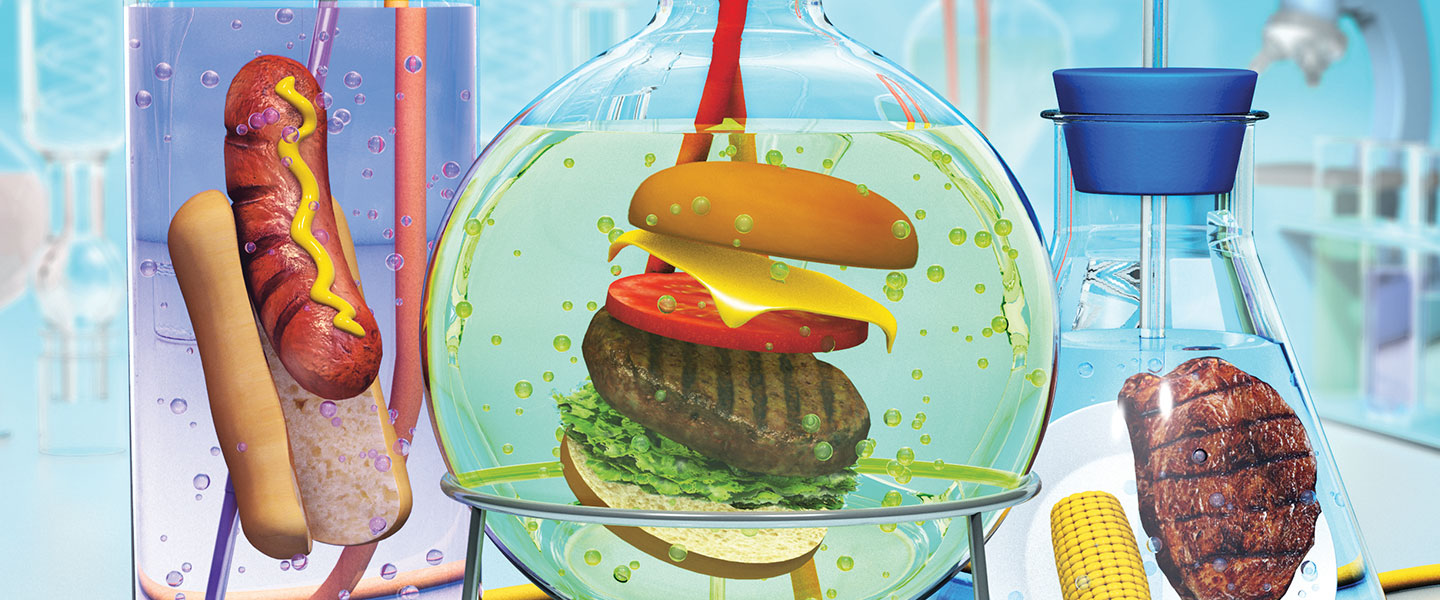The sizzle of hamburgers cooking on a backyard grill is a sure sign summer has arrived. You load up your plate and take a bite. Your burger tastes meaty and juicy, just as you’d expect. So you might be surprised to discover that the “beef” you’re eating didn’t actually come from a cow raised on a farm. It’s a meat alternative created by food scientists in a lab. These products look and taste almost like the real thing, but they’re made from plants or grown from animal cells, the smallest units of life.
Eating a diet high in real meat can have drawbacks, particularly when it comes to the environment, says Joseph Puglisi (see Farm to Table). He’s the scientific adviser for Beyond Meat, a plant-based-meat company in California. Raising livestock requires more energy, land, and water than growing crops or cells to make meat alternatives. It takes 218 liters (58 gallons) of water to produce one beef patty, but only 1.1 L (0.3 gal) to make a meatless Beyond Burger. Meat alternatives also create less waste, and they don’t require that any animals be harmed.
To make our diets more sustainable, says Puglisi, “we need to find a way to satisfy our desire for meat while also moving toward a plant-based diet.” Many people are embracing the idea. You can now order meat alternatives at restaurants or buy them at the grocery store for your next cookout. Check out some of the innovative foods you might encounter this summer
Hamburgers sizzle on a backyard grill. That’s a sure sign that summer is here. You fill your plate and take a bite. Your burger tastes meaty and juicy, just as you’d expect. So you might be surprised to learn where this “beef” came from. It’s not from a cow raised on a farm. It’s a meat alternative. Food scientists created it in a lab. These products look and taste almost like the real thing. But they’re made from plants or grown from animal cells, the smallest units of life.
A diet high in real meat can create problems. That’s especially true for the environment, says Joseph Puglisi (see Farm to Table). He’s the scientific adviser for Beyond Meat, a plant-based-meat company in California. Raising livestock requires energy, land, and water. Growing crops or cells to make meat alternatives uses less of these. It takes 218 liters (58 gallons) of water to produce one beef patty. But only 1.1 L (0.3 gal) is needed for a meatless Beyond Burger. Meat alternatives also create less waste, and no animals are harmed to make them.
Puglisi says we can make our diets more sustainable. To do that, he says, “we need to find a way to satisfy our desire for meat while also moving toward a plant-based diet.” Many people like the idea. Now you can order meat alternatives at restaurants. Or you can buy them at the grocery store for your next cookout. You might come across some of these inventive foods this summer. Turn the page to check them out.


 A small sample of muscle is taken from a cow.
A small sample of muscle is taken from a cow. Stem cells, which can turn into other types of cells, are taken from the muscle.
Stem cells, which can turn into other types of cells, are taken from the muscle.  The stem cells are given nutrients to grow into muscle cells. The sample multiplies into trillions of cells.
The stem cells are given nutrients to grow into muscle cells. The sample multiplies into trillions of cells.  Cells clump together to form tiny muscle fibers.
Cells clump together to form tiny muscle fibers.  The fibers are ground up to make ground meat.
The fibers are ground up to make ground meat.